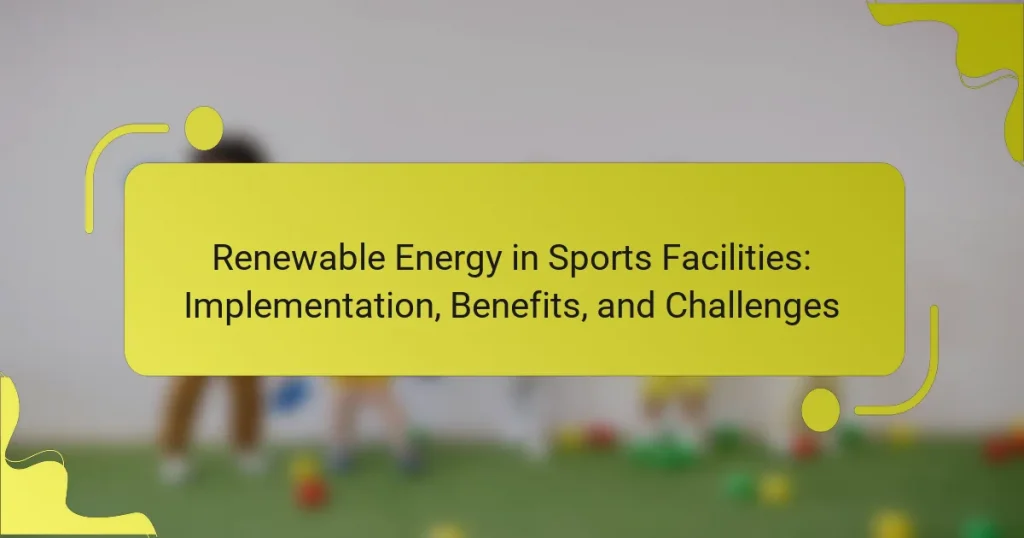Implementing renewable energy in sports facilities can lead to significant cost savings and a reduced carbon footprint. This article explores the benefits of renewable energy, the challenges faced during implementation, and successful case studies from notable venues like Mercedes-Benz Stadium and Levi’s Stadium. Additionally, it discusses common renewable sources such as solar, wind, and geothermal energy, along with strategies for optimizing these systems.

What are the key benefits of implementing renewable energy in sports facilities?
Implementing renewable energy in sports facilities offers significant benefits, including cost savings, reduced carbon footprint, and enhanced community reputation. These facilities can lower energy costs by utilizing solar panels or wind turbines, which often lead to long-term financial savings. Additionally, using renewable energy sources helps decrease greenhouse gas emissions, contributing to environmental sustainability. Furthermore, adopting green energy solutions can improve a facility’s public image, attracting eco-conscious patrons and sponsors.
How does renewable energy impact operational costs for sports venues?
Renewable energy significantly reduces operational costs for sports venues by lowering utility bills and minimizing reliance on fossil fuels. Facilities that implement solar panels or wind turbines can see savings of 20-50% on energy expenses. Additionally, renewable energy sources often qualify for tax incentives and grants, further decreasing financial burdens. Over time, the initial investment in renewable technology is offset by these savings, enhancing long-term financial sustainability for sports facilities.
Which environmental benefits are associated with renewable energy in sports facilities?
Renewable energy in sports facilities offers significant environmental benefits, including reduced greenhouse gas emissions and lower air pollution. These energy sources, such as solar and wind, minimize reliance on fossil fuels, promoting sustainability. Additionally, they contribute to energy efficiency and resource conservation, enhancing the overall ecological footprint of sports venues. Implementing renewable energy can also foster community engagement and awareness around environmental issues.
What role does renewable energy play in enhancing community engagement?
Renewable energy enhances community engagement by promoting sustainability and fostering local involvement. Sports facilities utilizing renewable energy sources, like solar panels, can reduce operational costs, allowing funds to be redirected towards community programs. This creates opportunities for local events and activities, strengthening community ties. Additionally, renewable energy initiatives can raise awareness about environmental issues, encouraging residents to participate in sustainability efforts.
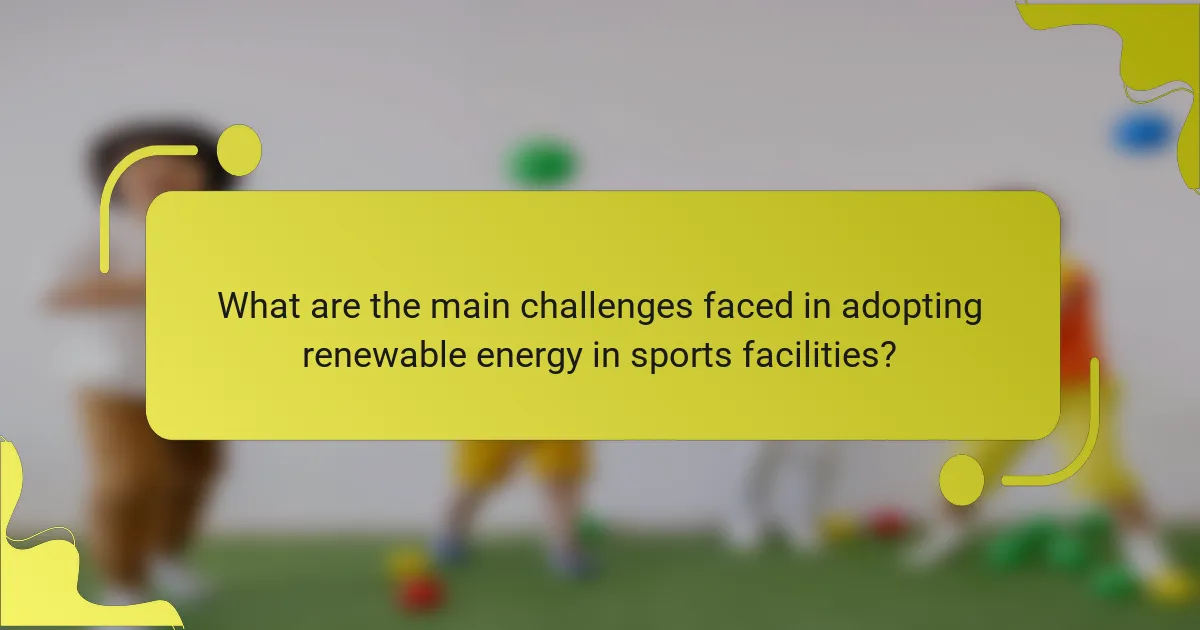
What are the main challenges faced in adopting renewable energy in sports facilities?
The main challenges in adopting renewable energy in sports facilities include high initial costs, limited space for installations, regulatory hurdles, and the need for specialized knowledge. These obstacles can hinder effective implementation. For example, solar panel installation requires significant upfront investment, which may deter facility managers. Additionally, integrating renewable systems with existing infrastructures often presents technical difficulties.
How do initial investment costs affect the decision to implement renewable energy?
Initial investment costs significantly influence the decision to implement renewable energy in sports facilities. High upfront expenses can deter facility managers from adopting sustainable technologies despite long-term savings and environmental benefits.
For example, solar panel installation may require substantial initial capital, but it can lead to reduced energy bills over time. Additionally, financial incentives, such as grants or tax credits, can mitigate these costs, making renewable energy more attractive.
Ultimately, careful financial planning and consideration of long-term benefits can encourage sports facilities to embrace renewable energy solutions.
What are the regulatory barriers to renewable energy adoption in sports venues?
Regulatory barriers to renewable energy adoption in sports venues include complex permitting processes, lack of financial incentives, and outdated building codes. These challenges hinder the integration of sustainable technologies. For instance, venues often face lengthy approval timelines that delay project implementation. Additionally, inconsistent regulations across regions can complicate compliance efforts, limiting investment in renewable energy solutions. Engaging with policymakers may help streamline these processes, promoting a more favorable environment for renewable energy initiatives in sports facilities.
How do sports facilities manage technological challenges in renewable energy integration?
Sports facilities manage technological challenges in renewable energy integration through strategic planning and innovative solutions. They often adopt advanced energy management systems to optimize energy use and monitor performance. Collaboration with renewable energy providers enhances access to cutting-edge technologies. Training staff on new systems is essential for effective integration and operation. Moreover, facilities may invest in research to address unique challenges, such as energy storage and grid compatibility.
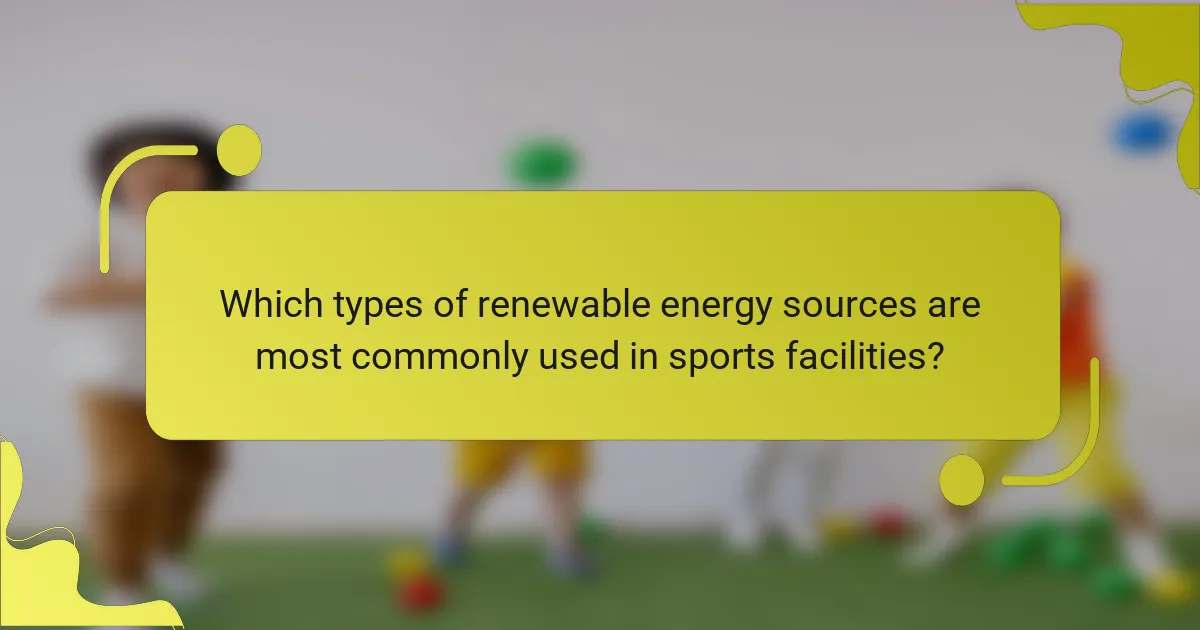
Which types of renewable energy sources are most commonly used in sports facilities?
Solar energy, wind energy, and geothermal energy are the most commonly used renewable energy sources in sports facilities. Solar panels are widely installed on rooftops, providing electricity and heating water. Wind turbines generate power, especially in open areas. Geothermal systems utilize the earth’s heat for temperature regulation. These sources contribute to sustainability and reduce operational costs.
How does solar energy contribute to the sustainability of sports venues?
Solar energy significantly enhances the sustainability of sports venues by reducing carbon footprints and operational costs. It provides a renewable energy source that minimizes reliance on fossil fuels. Sports facilities adopting solar power can achieve energy independence and lower utility expenses. For example, solar panels can generate electricity for lighting, scoreboards, and concessions, leading to a more eco-friendly operation. Additionally, the implementation of solar energy can attract environmentally conscious sponsors and fans, creating a positive brand image.
What role does wind energy play in powering sports facilities?
Wind energy plays a significant role in powering sports facilities by providing a sustainable and renewable energy source. Many sports venues are adopting wind turbines to reduce their carbon footprint and energy costs.
Wind energy systems can generate substantial electricity, often covering a large portion of a facility’s energy needs. For instance, a medium-sized wind turbine can produce around 400,000 kWh annually, enough to power multiple sports events.
The integration of wind energy also enhances the facilities’ public image, showcasing commitment to environmental responsibility. This renewable energy source can help mitigate operational challenges related to energy supply and pricing volatility.
Overall, wind energy supports sports facilities in achieving sustainability goals while ensuring reliable power for various operations and events.
Are there examples of geothermal energy usage in sports venues?
Yes, several sports venues utilize geothermal energy. For example, the Barclays Center in Brooklyn, New York, employs geothermal heating and cooling systems. This implementation reduces energy costs and minimizes environmental impact. Additionally, the University of Utah’s Rice-Eccles Stadium uses geothermal energy for heating, showcasing the potential of this renewable resource in enhancing sustainability in sports facilities. These examples highlight the benefits of geothermal energy, including lower operational costs and reduced carbon emissions.
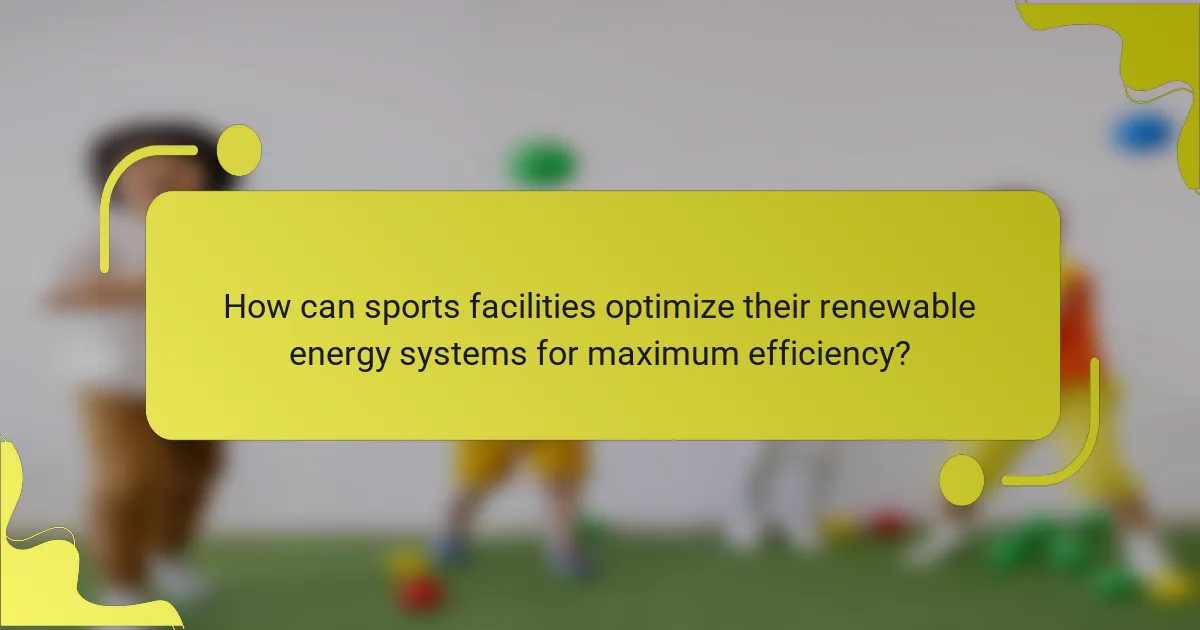
How can sports facilities optimize their renewable energy systems for maximum efficiency?
Sports facilities can optimize renewable energy systems by integrating advanced technologies, enhancing energy management, and prioritizing sustainable practices. Implementing smart grids improves energy distribution efficiency. Utilizing energy storage systems maximizes renewable energy use and reduces dependency on the grid. Regular maintenance and performance monitoring ensure systems operate at peak efficiency. Engaging in community partnerships can lead to shared resources and innovative solutions.
What best practices should be followed when implementing renewable energy solutions?
To implement renewable energy solutions effectively in sports facilities, focus on planning, stakeholder engagement, and technology selection.
1. Conduct a comprehensive energy audit to assess current usage and identify opportunities for renewable integration.
2. Engage stakeholders, including facility managers, athletes, and the community, to gather input and foster support for the initiative.
3. Choose appropriate renewable technologies, such as solar panels or wind turbines, based on local resources and facility needs.
4. Develop a phased implementation plan that includes timelines, budgets, and performance metrics to evaluate success.
5. Ensure compliance with local regulations and standards to avoid legal challenges during implementation.
6. Monitor and maintain renewable systems regularly to maximize efficiency and performance over time.
How can facilities monitor and evaluate the performance of renewable energy systems?
Facilities can monitor and evaluate renewable energy systems through real-time data analytics and performance metrics. Utilizing advanced monitoring tools allows for tracking energy production, consumption, and system efficiency. Regular audits and maintenance checks ensure optimal performance and identify areas for improvement. Additionally, benchmarking against industry standards helps assess effectiveness and sustainability.
What common mistakes should be avoided during the implementation of renewable energy?
Common mistakes during the implementation of renewable energy in sports facilities include inadequate planning, overlooking local regulations, and neglecting stakeholder engagement.
First, failing to conduct thorough feasibility studies can lead to poor investment decisions. Second, not considering the specific energy needs of the facility may result in inefficient systems. Third, ignoring maintenance requirements can lead to increased long-term costs. Lastly, underestimating the importance of community involvement can hinder project acceptance and support.
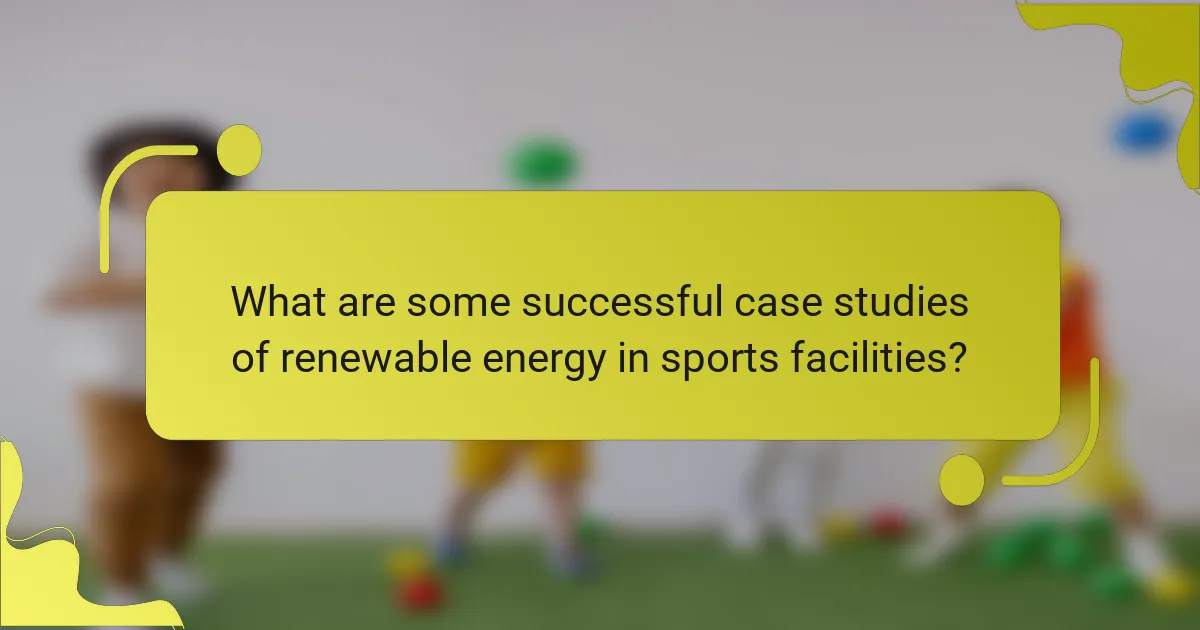
What are some successful case studies of renewable energy in sports facilities?
Several sports facilities have successfully implemented renewable energy solutions, showcasing their benefits and overcoming challenges. Notable examples include the Mercedes-Benz Stadium in Atlanta, which uses solar panels to offset energy consumption, and the Levi’s Stadium in California, featuring a comprehensive solar array that provides significant energy savings. These facilities demonstrate reduced operational costs and enhanced sustainability, while also facing challenges like initial investment and technology integration.
Which sports venues have effectively integrated renewable energy solutions?
Several sports venues have effectively integrated renewable energy solutions, including the Mercedes-Benz Stadium, Levi’s Stadium, and the Barclays Center. These facilities utilize solar panels, wind turbines, and energy-efficient systems to reduce their carbon footprint. For example, the Mercedes-Benz Stadium in Atlanta generates 100% of its energy needs from renewable sources. Levi’s Stadium in California features a solar array that produces 1.2 megawatts of energy. The Barclays Center in Brooklyn has implemented energy-efficient lighting and heating systems, significantly lowering energy consumption. These initiatives highlight the growing trend of sustainability in sports facilities.
How have international sports events leveraged renewable energy for sustainability?
International sports events have increasingly adopted renewable energy to promote sustainability. These initiatives reduce carbon footprints and enhance energy efficiency. For example, the use of solar panels at stadiums provides clean power, while wind energy supports event operations. Challenges include high initial costs and infrastructure limitations. However, the long-term benefits, such as reduced operational costs and positive public perception, outweigh these obstacles.
What lessons can be learned from pioneering sports facilities in renewable energy adoption?
Pioneering sports facilities demonstrate that renewable energy adoption leads to significant operational savings and environmental benefits. These facilities often utilize solar panels, wind turbines, and energy-efficient systems, showcasing practical applications. For instance, the Barclays Center in Brooklyn uses a 1.2 MW solar installation, reducing energy costs by 20%. Lessons from these implementations include the importance of upfront investment, community engagement, and ongoing maintenance. Additionally, they highlight the potential for unique attributes, such as energy independence and enhanced public image, to drive further adoption in the sports sector.
